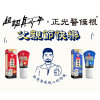Diclofenac, painkiller and anti-inflammatory medication listed as top five suspected drugs
The medications and pain relief patches contain the analgesic and anti-inflammatory ingredient "Diclofenac." In 2021, it was declared for insurance claims totaling 110 million NTD, making it one of the commonly used medications. However, it ranks as the fifth-largest drug in terms of historical drug relief payments, with over 100 cases of drug relief payments. If patients experience symptoms such as swollen eyes, difficulty breathing, or hives after using this type of medication, they should seek medical attention immediately.
Background and Data of Drug Relief System
In our country, the drug relief system has been in place for 24 years, with a total of 2,318 cases receiving payments. The top five suspicious drugs include medications for treating gout, epilepsy, and tuberculosis. According to regulations, when individuals legally use medication according to a doctor's prescription or pharmacist's instructions and experience severe adverse reactions, they can apply for drug relief and receive different amounts of compensation based on the degree of disability, with a maximum of 3 million NTD.
Uses and Potential Risks of Diclofenac
Diclofenac is a common anti-inflammatory and pain-relieving medication used for reducing fever, relieving headaches, and alleviating muscle soreness. In addition to oral tablets and suppositories for children, it is also available in forms such as pain relief patches and ointments sold in pharmacies. While adverse reactions after using Diclofenac are rare, caution should still be exercised. If symptoms like swollen eyes, difficulty breathing, skin ulceration, or blistering occur, prompt medical attention is advised. Minor allergic reactions during the first use may not raise sufficient alarm, but subsequent uses may result in more severe reactions.
The Other Four Drugs Prone to Adverse Reactions
Apart from Diclofenac, the other four drugs prone to adverse reactions are:
Top Suspected Drug: Gout medication "Allopurinol"
Second Suspected Drug: Anti-epileptic drug "Phenytoin"
Third Suspected Drug: Tuberculosis medication "Rifampin/Isoniazid/Pyrazinamide"
Fourth Suspected Drug: Anti-epileptic drug "Carbamazepine"
Fifth Suspected Drug: Non-steroidal anti-inflammatory drug "Diclofenac"
Conclusion
Commonly available Western medicine pain relief patches containing the pain-relieving and anti-inflammatory ingredient "Diclofenac" are a common medication. However, it ranks fifth in terms of drug relief payments. Additionally, there are four other drugs that are also prone to adverse reactions. Patients should exercise extra caution when using them and consider genetic testing if necessary. In case of any abnormal reactions after using these drugs, seeking prompt medical attention is crucial to avoid further health risks.
Reducing the Risk of Adverse Reactions from Medication Use
Adhere to Doctor or Pharmacist's Instructions
Before using medication, carefully read and follow the instructions provided by the doctor or pharmacist. Strictly adhere to the prescribed dosage and usage, and avoid adjusting doses or switching medications without proper guidance.
Report Any Abnormal Reactions Promptly
If any abnormal reactions occur after using medication, such as swollen eyes, difficulty breathing, hives, etc., it is essential to report them promptly to healthcare professionals and seek appropriate medical assistance.
Consider Medication Allergy Genetic Testing
For drugs known to potentially cause adverse reactions, it is recommended to undergo medication allergy genetic testing before the initial use to assess individual tolerance to the medication.








